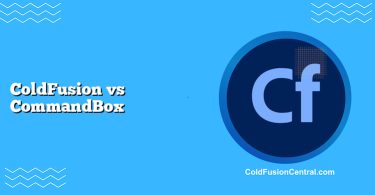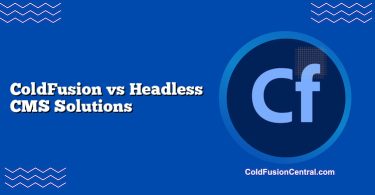Definitions
- ColdFusion (CFML): A rapid application development platform built on the JVM, historically from Adobe (Adobe ColdFusion) with an open-source alternative (Lucee). It uses the CFML language to create server-side web applications quickly with tag-based and script syntax, strong integration features, and an administrative console.
- .NET (ASP.NET Core): A free, open-source, cross-platform developer platform by Microsoft for building web, APIs, microservices, desktop, and cloud applications. ASP.NET Core is the modern web framework within .NET, typically using C#, with powerful tooling, performance, and a vast ecosystem.
Overview
Both ColdFusion and .NET are used to build server-side web applications and APIs, but they differ in philosophy, runtime, and ecosystem:
- ColdFusion emphasizes productivity and simplicity for web development, offering many batteries-included features for form handling, PDF generation, mail, caching, ORM, and integration.
- .NET emphasizes performance, modularity, and flexibility, excelling at microservices, API-driven architecture, and high-scale enterprise systems.
If you maintain CFML applications or prioritize rapid delivery with a small team, ColdFusion can be a great fit. If you need high-performance APIs, cross-platform services, or deep integration with Azure and modern DevOps practices, .NET is often the default choice.
Key Features
ColdFusion Highlights
- Rapid development with tag-based CFML and script-style syntax.
- Built-in services (PDF generation, image manipulation, REST endpoints, schedulers, mail, caches).
- ORM support (Hibernate-based), CFQuery for databases, easy datasources.
- Admin console for settings, security lockdown, data sources, and caching.
- Commercial edition (Adobe ColdFusion) with support; Lucee as a free/open-source alternative.
.NET (ASP.NET Core) Highlights
- High-performance Kestrel web server and async-first programming model.
- Minimal APIs, MVC, Razor Pages, SignalR for real-time.
- Rich libraries: Entity Framework Core (ORM), gRPC, Identity, Data Protection.
- First-class tooling (Visual Studio, Rider, VS Code), CI/CD integration, containers.
- Cross-platform runtime (Windows, Linux, macOS) and broad cloud support (Azure, AWS, GCP).
Supported Platforms
- ColdFusion
- Runtime: JVM (Java 11+ depending on version)
- Servers: Adobe ColdFusion (commercial), Lucee (open-source)
- OS: Windows, Linux, macOS
- Containerization: Supported (official images for recent versions), works well with Tomcat/Jetty
- .NET (ASP.NET Core)
- Runtime: .NET 6/7/8 (cross-platform)
- OS: Windows, Linux, macOS
- Containerization: First-class support with slim runtime images; excellent for microservices and Kubernetes
Language Syntax at a Glance
- ColdFusion (CFML) example inline:
- Query: cfquery name=”q” datasource=”myDSN” SELECT * FROM Users WHERE id =
- REST: component rest=”true” restPath=”users” function get() httpmethod=”GET”
- .NET (C#) example inline:
- Query (EF Core): await db.Users.FindAsync(id);
- Minimal API: app.MapGet(“/users/{id}”, (int id, AppDb db) => db.Users.FindAsync(id));
Both ecosystems offer robust DB tooling, validation, and routing; .NET leans toward strongly typed abstractions, while CFML favors quick, expressive constructs.
Performance
- .NET (ASP.NET Core) typically ranks among the fastest web frameworks in independent benchmarks, thanks to the Kestrel server, async I/O, and continuous runtime optimizations. It is well-suited for high-throughput APIs and microservices.
- ColdFusion performance is solid for traditional web apps but generally lags behind .NET for raw throughput. The JVM provides JIT optimizations, but CFML’s dynamic nature and framework overhead add latency. Performance is often “good enough” for line-of-business apps and intranet portals, especially when caching and connection pooling are configured.
Tips:
- ColdFusion: leverage query caching, in-memory caches, and tune JVM/connector settings; avoid excessive dynamic evaluation.
- .NET: favor async/await endpoints, pooled HttpClient, and minimal allocations; configure thread pools and GC settings for high-load scenarios.
Scalability
- ColdFusion
- Vertical scaling is straightforward; horizontal scaling is achieved via multiple instances, sticky sessions, or external session stores.
- Adobe ColdFusion Enterprise offers clustering features and event gateways; Lucee supports clustering via classic Java web stack approaches.
- Works well behind Nginx/Apache/IIS and within Docker/Kubernetes, but the ecosystem for microservices is smaller.
- .NET
- Designed for horizontal scale with stateless services; integrates seamlessly with load balancers, service meshes, and Kubernetes.
- Strong microservices tooling (gRPC, Dapr, YARP, Event Grid, Azure Service Bus).
- Superb elasticity in cloud platforms (Azure App Service, Azure Container Apps, AWS ECS/EKS).
Security
- ColdFusion
- Admin console features, secure profile modes, lockdown guides, anti-CSRF tokens, and OWASP-focused tooling.
- Historically vulnerable when the admin is exposed or default configurations are not hardened; follow lockdown guides.
- Built-in functions for input validation, parameterized queries (cfqueryparam), and session security.
- .NET
- Mature identity and auth frameworks (ASP.NET Core Identity, OpenID Connect, OAuth 2.0).
- Data Protection, XSRF/CSRF mitigation, strong HTTPS defaults, secret management via Key Vault/Secrets Manager.
- Extensive security guidance and frequent updates via NuGet and .NET security advisories.
Both stacks can be secure when hardened; .NET typically provides more prescriptive security patterns out of the box for enterprise SSO and zero-trust architectures.
Cost and Licensing
- ColdFusion
- Adobe ColdFusion is commercial, licensed typically per core; Standard vs Enterprise tiers differ in features and scalability.
- Lucee is open-source and free; commercial support can be purchased via third parties.
- Consider TCO: licenses, support contracts, JVM hosting, and admin expertise.
- .NET
- .NET SDK and ASP.NET Core are free and open-source.
- Tooling is free (VS Code) or paid (Visual Studio Professional/Enterprise) but not required.
- Hosting and cloud spend dominate costs; licensing primarily applies to Windows Server/SQL Server if chosen.
If minimizing licensing costs is key, .NET and Lucee are cost-effective; Adobe ColdFusion suits teams valuing vendor support and integrated features.
Community and Ecosystem
- ColdFusion
- Smaller community, longer enterprise legacy (government, education, media).
- Plugins/modules exist (ColdBox, CommandBox), but the ecosystem is modest compared to .NET.
- Documentation is solid, with vendor support options.
- .NET
- Massive global community, extensive documentation, samples, and StackOverflow presence.
- Rich NuGet ecosystem for virtually any task (caching, logging, observability, ML, cloud).
- Frequent updates and LTS releases, excellent CI/CD and DevOps tooling.
Side-by-Side Comparison
| Aspect | ColdFusion (Adobe/Lucee) | .NET (ASP.NET Core) |
|---|---|---|
| Runtime | JVM-based (Tomcat/Jetty) | Cross-platform .NET runtime |
| Language | CFML (tags + script) | C# (primarily), F#, VB |
| Performance | Moderate; good for LOB apps | Excellent; top-tier in benchmarks |
| Scalability | Clustering and instances; adequate for most apps | Horizontal scale, microservices-ready |
| Security | Strong features; needs hardened config | Strong defaults; rich auth/identity tooling |
| Cost | Adobe: licensed; Lucee: free | Free; optional paid IDE; hosting costs |
| Tooling | Admin console; CFBuilder/VS Code | Visual Studio, VS Code, Rider |
| Ecosystem | Smaller, focused | Huge; NuGet-rich; cloud-native |
| Typical Use Cases | Rapid CRUD, forms, reporting, legacy CFML | High-performance APIs, microservices, enterprise systems |
| Pros | Rapid development, built-ins (PDF/email), simple DB access | Performance, ecosystem, cloud-native, strong typing |
| Cons | Licensing (Adobe), smaller talent pool | Learning curve, complexity of choices |
Real-World Use Cases
When ColdFusion Shines
- Scenario: A university IT team needs to convert a patchwork of departmental forms and reports into a unified portal within months. They have one CFML developer and a Java admin.
- Why ColdFusion: Quick-to-build forms, built-in PDF generation and email, easy database queries with cfqueryparam, admin console for data sources, scheduled tasks for nightly jobs. Minimal boilerplate enables faster delivery without assembling many third-party components. Lucee can further reduce licensing cost.
When .NET Is Preferred
- Scenario: A fintech company is building a low-latency API platform with 50+ microservices, Kafka event streams, and aggressive SLAs. They plan to deploy to Kubernetes with autoscaling.
- Why .NET: High performance with async I/O, first-class container support, gRPC for service-to-service communication, strong typing and codegen for contracts, built-in observability with OpenTelemetry, and seamless Azure integration for identity and secrets. Hiring C#/.NET engineers is easier at scale.
Development Workflow and Tooling
- ColdFusion
- Setup: Install CF server (Adobe/Lucee), configure datasources in admin, deploy via WAR/CFAR or Docker.
- Productivity: Rapid prototyping with CFML; CommandBox and ColdBox help modernize workflows; good for monoliths and modular monoliths.
- .NET
- Setup: dotnet new webapi; run via dotnet run or container. CI/CD with GitHub Actions/Azure DevOps straightforward.
- Productivity: Strong refactoring, analyzers, and testing; templates for MVC, Minimal APIs, Blazor; top-tier debugging and profiling.
Step-by-Step Considerations for Migration or Greenfield
- Define requirements: latency, throughput, concurrency, integrations, compliance.
- Decide architecture: monolith vs microservices; deployment targets (VMs, containers, PaaS).
- Evaluate team skills: CFML/Java vs C#/F#; hiring strategy and training.
- Prototype critical paths: DB access, auth, file/PDF generation, external APIs.
- Benchmark: Establish performance budgets; test with realistic data and payloads.
- Security hardening: Lockdown admin consoles (CF), configure HTTPS/HSTS, secrets, SSO.
- Observability: Logging, metrics, tracing; select APMs (New Relic, Application Insights).
- Plan rollout: Blue/green or canary, database migrations, and rollback strategies.
- Governance: Versioning practices, code reviews, dependency scanning, patch cadence.
Pros and Cons
ColdFusion Pros
- Rapid application development; minimal boilerplate for CRUD, forms, PDF, email.
- Easy database access and built-in ORM; scheduler and caching out of the box.
- Admin console centralizes configuration and security features.
- Lucee option reduces licensing costs while retaining CFML productivity.
ColdFusion Cons
- Smaller talent pool and ecosystem; harder hiring and fewer libraries.
- Adobe licensing can be expensive at scale; enterprise features gated by edition.
- Performance ceiling lower than .NET for high-throughput scenarios.
- Historically sensitive to misconfiguration; must follow lockdown guides.
.NET Pros
- Top-tier performance, great for APIs and microservices.
- Huge ecosystem, strong tooling, and community support.
- Excellent cloud-native story (containers, Kubernetes, DevOps pipelines).
- Strong typing improves maintainability, refactoring, and reliability.
.NET Cons
- More choices increase complexity; steeper learning curve for greenfield teams.
- Some features (e.g., PDF generation) require third-party libraries.
- Enterprise identity and security patterns can feel heavyweight initially.
Decision Factors / Which One Should You Choose?
Choose ColdFusion if:
- You need to deliver data-driven web apps quickly with a small team.
- PDF/report generation, forms processing, and scheduled jobs are core features.
- You are maintaining or extending existing CFML systems.
- You prefer an integrated, managed runtime with minimal assembly of third-party parts.
- You are fine with commercial licensing (Adobe) or are comfortable with Lucee + community support.
Choose .NET if:
- You require high-performance APIs, real-time apps, or microservices at scale.
- You want a broad hiring pool, long-term ecosystem momentum, and cloud-native patterns.
- You need deep integration with Azure/AWS services, SSO, and enterprise security.
- You value strong typing, advanced tooling, and maintainability for large codebases.
- You want to minimize licensing fees while maximizing platform flexibility.
Pragmatic tip:
- For mixed environments, use .NET for core APIs/microservices and keep ColdFusion for content-heavy admin portals or legacy workflows. Interoperate via REST/gRPC and gradually evolve the estate.
Key Takeaways
- ColdFusion excels at rapid application development with built-in features for web apps, especially where forms, PDFs, and quick database work dominate requirements.
- .NET leads in performance, scalability, and cloud-native capabilities, backed by a massive ecosystem and strong enterprise patterns.
- Cost, team skills, performance targets, and ecosystem needs should drive the decision more than brand familiarity.
- For greenfield high-scale API platforms, .NET is usually the safer long-term bet; for quick line-of-business apps or CFML continuity, ColdFusion remains highly productive.
FAQ
Is ColdFusion still relevant for new projects?
Yes, especially for rapid line-of-business apps, content management, and reporting-heavy workflows. With Lucee, you can avoid licensing costs. That said, for high-scale distributed systems, .NET generally offers better performance and ecosystem fit.
Can I containerize ColdFusion and .NET applications?
Yes. Both run well in Docker. ColdFusion has official images for recent versions; .NET provides lightweight images and strong orchestration tooling for Kubernetes. Observability and configuration should be planned early.
How hard is it to migrate from ColdFusion to .NET?
It depends on app size and dependencies (PDF, mail, ORM). Common approach: expose existing functionality via REST, build new modules in .NET, and gradually replace CFML pages. Data access and auth need careful mapping (EF Core vs CF ORM).
Which databases work best with each stack?
Both support major RDBMS (SQL Server, Oracle, MySQL/MariaDB, PostgreSQL). .NET’s EF Core offers mature LINQ-based access; ColdFusion provides cfquery and Hibernate-based ORM. Choice often comes down to team preference and licensing.
What about long-term maintenance and hiring?
.NET has a much larger talent pool and community, easing hiring and training. ColdFusion talent is available but more niche. For large organizations, this difference can significantly influence TCO over time.




